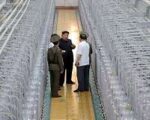U.S. Marine Corps F-35B Lightning II jets have landed in Puerto Rico for the first time as part of a forward deployment exercise aimed at enhancing expeditionary combat capabilities and signaling strategic presence in the Caribbean. The deployment underscores evolving U.S. posture amid growing geopolitical interest in the region.
F-35Bs from MAG-13 Conduct First-Ever Deployment to Puerto Rico
On September 13, 2025, a detachment of U.S. Marine Corps F-35B Lightning II aircraft assigned to Marine Aircraft Group 13 (MAG-13), part of the 3rd Marine Aircraft Wing (3rd MAW), touched down at Muñiz Air National Guard Base in San Juan, Puerto Rico. This marks the first known deployment of F-35Bs to the island territory.
The aircraft are participating in an Agile Combat Employment (ACE) exercise designed to test expeditionary basing concepts and short-notice deployments across dispersed locations. The ACE concept—central to U.S. Indo-Pacific and global force posture—is intended to complicate adversary targeting by enabling rapid dispersal and flexible operations from austere or semi-prepared airfields.
The deployment was supported by KC-130J aerial refueling tankers from VMGR-352 (“Raiders”), which provided mid-air refueling during the transit from Marine Corps Air Station Yuma, Arizona.
Strategic Significance of Caribbean Basing
While Puerto Rico is a U.S. territory with longstanding military infrastructure—including Coast Guard Sector San Juan and Army Reserve components—the arrival of fifth-generation fighters represents a notable escalation in capability projection within the region.
This move comes amid renewed attention on the Caribbean’s strategic value due to several converging factors:
- Growing Chinese economic influence and port infrastructure investments across Latin America and the Caribbean.
- Russian naval deployments and joint exercises with Venezuela and Cuba.
- Transnational criminal networks exploiting regional instability.
The presence of F-35Bs—capable of short takeoff/vertical landing (STOVL) operations—allows for flexible basing options across islands with limited runway infrastructure. It also serves as a deterrent signal that advanced airpower can be rapidly projected into contested or neglected theaters.
Testing Expeditionary Advanced Base Operations (EABO)
This deployment aligns with broader U.S. Marine Corps Force Design 2030 reforms that emphasize distributed operations through Expeditionary Advanced Base Operations (EABO). EABO envisions small units operating from temporary or austere locations with organic sustainment and mobility—often supported by STOVL platforms like the F-35B.
In this context, Puerto Rico provides an ideal testbed for logistical throughput assessments, command-and-control integration with joint forces (including Air National Guard assets), and evaluation of local support infrastructure under realistic conditions.
The use of Muñiz ANGB—a dual-use civilian/military facility co-located with Luis Muñoz Marín International Airport—also tests deconfliction procedures between military sorties and commercial traffic under ACE scenarios.
MAG-13’s Role in Global Force Posture Experiments
MAG-13 has been increasingly involved in forward-deployed experimentation missions involving STOVL operations from non-traditional bases. In recent years, its squadrons have trained extensively on ACE concepts across Pacific islands such as Tinian and Palau under Exercise “Valkyrie Forge” and “Pacific Iron.”
The current mission builds on that experience but shifts focus toward Western Hemisphere contingencies—a region often overshadowed by Indo-Pacific priorities but increasingly relevant due to gray-zone threats and great-power competition spillover into Latin America.
The unit’s ability to deploy rapidly over thousands of kilometers—with organic aerial refueling support—and operate from semi-permissive environments demonstrates growing maturity in expeditionary fifth-gen fighter employment doctrine.
Implications for Regional Allies and Adversaries
This high-profile movement is likely being closely monitored by both regional partners such as Colombia and Dominican Republic—as well as adversarial observers including Venezuela’s Maduro regime and Cuban intelligence services.
For allies, it signals enhanced interoperability opportunities through future joint training or security cooperation engagements involving next-gen platforms like F-35s or MQ-9s operating out of shared facilities. For adversaries, it reinforces that even peripheral theaters are within reach of American precision strike capabilities backed by stealth survivability features.
The deployment may also serve as a template for future rotational presence models similar to those used at Andersen AFB (Guam) or RAF Fairford (UK), wherein high-end assets rotate through forward locations without permanent basing commitments—thereby reducing political friction while maintaining operational readiness options globally.
Sustainment Challenges Highlighted During Deployment
A key focus area during this exercise is sustainment resilience under expeditionary conditions—a known challenge area for fifth-generation systems like the F-35B due to their complex logistics tail including ALIS/ODIN data systems, low-observable coating maintenance needs, and specialized tooling requirements.
Preliminary reports indicate that MAG-13 deployed an organic maintenance detachment along with mobile ALIS nodes integrated into hardened shelters at Muñiz ANGB. Coordination with local contractors was also trialed for ground handling services—offering insights into hybrid public-private support models under EABO frameworks.
Looking Ahead: Toward Broader Regional Integration?
If successful, this proof-of-concept could pave the way for more frequent deployments not only to Puerto Rico but also other strategically located islands such as Curaçao (home to HATO airfield used by U.S. Southern Command), Guadeloupe/French territories (via NATO partnerships), or even forward operating sites in Central America under bilateral agreements.
This would expand options for distributed lethality operations across SOUTHCOM’s area of responsibility while reinforcing deterrence messaging against malign actors seeking footholds near critical sea lines of communication like the Panama Canal or Windward Passage chokepoints.
Conclusion
The arrival of F-35Bs in Puerto Rico marks more than just an aviation milestone—it reflects an evolving approach toward flexible power projection using fifth-generation platforms tailored for contested logistics environments. As great-power rivalry extends into previously overlooked regions like the Caribbean basin, such deployments will likely become more frequent components of integrated deterrence strategies blending technology with agile doctrine execution on a global scale.









